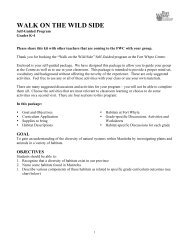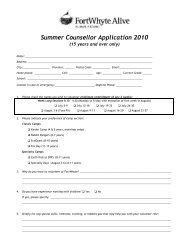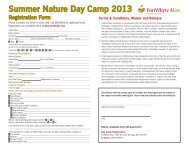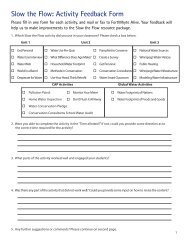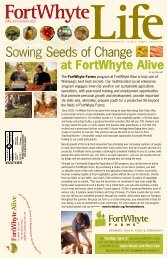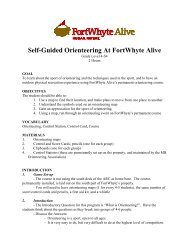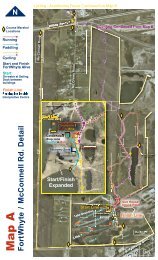WEATHERING THE CLIMATE - FortWhyte Alive
WEATHERING THE CLIMATE - FortWhyte Alive
WEATHERING THE CLIMATE - FortWhyte Alive
You also want an ePaper? Increase the reach of your titles
YUMPU automatically turns print PDFs into web optimized ePapers that Google loves.
<strong>WEA<strong>THE</strong>RING</strong> <strong>THE</strong> <strong>CLIMATE</strong><br />
Grade 4-6<br />
Please share this kit with the other teachers in your group.<br />
Thank you for booking <strong>FortWhyte</strong> <strong>Alive</strong>’s Adapt or Die! Program. The goal of this program<br />
is to have students gain an appreciation for weather and climate, how they differ,<br />
and how they are changing. Students will learn about sun and water, and how they drive<br />
the weather machine of Manitoba and Canada.<br />
CURRICULUM LINKS<br />
SLO: 4-1-04<br />
SLO: 5-4-06, 07, 16<br />
SLO: 6-3-16, 18<br />
OBJECTIVES<br />
Students will:<br />
1. Describe weather and climate<br />
2. Identify tools of weather and weather forecasting (prediction)<br />
3. Understand climate and how it affects plants and animals, including humans<br />
4. Recognize that both natural change and human actions can affect climate<br />
VOCABULARY<br />
Air pressure: the weight of the air over a given location. There are generally areas of high<br />
pressure or low pressure. Air pressure or barometric pressure is measured with a<br />
barometer.<br />
Anemometer: instrument used for measuring the force of wind.<br />
Atmosphere: the gaseous layer or envelope that surrounds the Earth. The gases are held in<br />
place by gravity.<br />
Barometer: instrument used for measuring atmospheric or barometric pressure.<br />
Climate: the prevailing trend of weather conditions. A long term assessment on weather and<br />
the statistical analysis of weather data.<br />
Climate change: the term used to describe fluctuations in the Earth’s climate over time.<br />
Past climates have changed due to a number of natural phenomena, however, we are<br />
now experiencing an unprecedented rate of climate change due to human activity.<br />
Forecast: an estimate or prediction about upcoming weather<br />
Greenhouse effect: a natural process that traps heat in the atmosphere. Heat rays enter<br />
the Earth’s atmosphere and become trapped, much like heat in a greenhouse. Without<br />
this natural phenomenon, the Earth would be –18°C year round and uninhabited.
Troposphere: the layer of the atmosphere that is closest to the Earth. The troposphere is<br />
the weather layer and the layer in which we live.<br />
Stratosphere: the layer of the atmosphere above the troposphere. 90% of the gases in the<br />
atmosphere can be found within the troposphere and stratosphere.<br />
Weather: state of the atmosphere at any given time. It is the day-to-day variation of the<br />
atmosphere and their effects on life and human activity.<br />
Wind chill: the combined cooling effect of wind and temperature.
PRE-VISIT ACTIVITIES<br />
1. Calculate Your Field Trip Carbon Balance<br />
There are many reasons to plant a tree – beautifying your school yard, cooling your house,<br />
providing wildlife habitat. Now there’s another reason. And it will affect people all over the<br />
planet. This year, plant a tree for climate change! Climate change is a serious environmental<br />
issue caused by our dependence on fossil fuels. We burn fossil fuels to heat our homes,<br />
power factories and run our cars and busses. The result of burning fossil fuels is the release of<br />
carbon dioxide into the atmosphere, causing our planet to heat up. Trees remove and store<br />
carbon dioxide from the atmosphere and create oxygen which enables us (and animals) to<br />
survive.<br />
Carbon Sources: Finding the Culprits<br />
The Earth’s climate fluctuates over the course of thousands of years, however, this is<br />
the first time in the Earth’s history where living things have caused the Earth’s climate<br />
to become warmer.<br />
The addition of extra greenhouse gases to the atmosphere traps more heat on Earth.<br />
Human activities – driving cars and heating homes - are increasing greenhouse gases at<br />
unprecedented rates. Carbon dioxide (CO 2 ) is an important greenhouse gas, one of the<br />
“heat-rebounders” in the atmosphere. CO 2 is also the product of fossil fuel combustion<br />
– it is spewing out the tailpipes of automobiles by the tonne – one of the many<br />
CARBON SOURCES. Since the Industrial Revolution, we have increased CO 2 in the<br />
atmosphere by 30% - this may not sound like a lot but it has already caused an<br />
increase in the average global temperature. Scientists are no longer saying “if” but<br />
“how warm” and they agree that the consequences will be dramatic and costly.<br />
The results for Manitoba are not just warmer temperatures - they include more extreme<br />
weather events, droughts, forest fires, dieback of the boreal forest, pest outbreaks<br />
(including mosquitoes); all of which will disable our economy. The impact of climate<br />
change is starting to be felt…right now.<br />
Carbon Sinks: Trees to the Rescue!<br />
How Many Trees<br />
How many trees do you need to plant to create a FWC Field Trip Carbon Balance<br />
How will you travel to Fort Whyte Centre Choose a. or b.<br />
a. Travel by Car _______ cars x _______ km = _______ Total km.<br />
_______Total km x 0.25 ÷ 9 = _______ trees!<br />
Our School will plant _______ trees to create a Field Trip Carbon Balance. These<br />
trees will absorb all the carbon dioxide produced by our cars today, travelling from school<br />
to Fort Whyte and back.
. Travel by Bus _______ km x 0.54 ÷ 9 = _______ trees!<br />
Our School will plant _______ trees to create a Field Trip Carbon Balance. These<br />
trees will absorb all the carbon dioxide produced by our bus today, travelling from school<br />
to Fort Whyte and back.<br />
2. The Weight of Air<br />
Blow up two balloons the same size. (HINT: blow up the balloons as much as possible) Use a<br />
string and tie one balloon to each end of a metre stick. Tie another string to the mid point of<br />
the meter stick and hang the stick with the balloons balanced on each end. When it’s<br />
balanced, use a pin to pop one of the balloons. What happens The other balloon dips down<br />
right away. Why Because the air in the inflated balloon has weight and is heavier than the<br />
one without air. This is how air masses move and “push each other around” to create a front.<br />
A front is the forward edge of an advancing mass of warm or cool air.<br />
3. Air Pressure<br />
Because air has weight it can exert pressure. Warm, moist air rises and is associated with low<br />
pressure areas. As this air rises, it cools and the water vapor in it condenses (this is how<br />
clouds are formed). Cool air sinks and compresses, causing high pressure, which results in<br />
clear conditions. To demonstrate the effect of air pressure, suck the air out of a plastic pop<br />
bottle. (HINT: it is easiest if you use small pop bottles) Why has the bottle collapsed<br />
Because the air on the outside is pushing inwards. When you remove the air from the inside<br />
of the bottle, there is nothing left to balance the pressure of the air on the outside.<br />
4. Make an anemometer<br />
Attach a ping-pong ball to a piece of thread. Tie the other end of the thread to the center of<br />
a protractor. By holding the protractor parallel to the wind, you will be able to read the angle<br />
the ball is blown by the wind. Use the chart below to estimate the wind speed.<br />
ANGLE 90° 85° 80° 75° 70° 65° 60° 55° 50° 45° 40° 35° 30° 25° 20°<br />
WIND<br />
SPEED<br />
(km/hr)<br />
0 9 13 16 19 22 24 26 29 32 34 38 42 46 52<br />
5. Wind Chill Activities<br />
Find out how long it takes for water to freeze. Take a container of water outside under<br />
different weather conditions. (HINT: start with the same quantity and temperature of water<br />
each time). Time how long it takes before the water freezes. Challenge the students to<br />
predict what will happen under different conditions.<br />
Use two thermometers to see what the effect of shelter has on temperature. While inside,<br />
place one thermometer in a shoe box, and tape the other to the outside. Make sure both<br />
thermometers start at the same temperature. Take the container outside into the wind and<br />
measure the drop in temperature over time. Graph the results. Try the experiment in
different weather conditions, or try using different types of containers with more or less<br />
insulation.<br />
6. Lightning on the Loose<br />
It all starts with the build up of static electricity in a storm cloud. Lightning is caused by the<br />
friction of rapidly moving ice particles and rain in a thundercloud. As a result of these built up<br />
electrical charges you see a bolt of lightening streaking through the sky. To demonstrate how<br />
static electricity forms:<br />
• Blow up two balloons and rub them on your sleeve. Then touch them together in a dark<br />
room. You should see sparks of static electricity.<br />
• Run a comb through your hair and then put it into a bowl of puffed rice. Grains of rice will<br />
stick to the comb.<br />
• Shuffle across a carpet in a dark room, then touch a doorknob or other metal object. You<br />
will see a spark jump from your finger to the metal object.<br />
7. Making a Cloud<br />
Important points to understand:<br />
• Three things are necessary for cloud formation: cooling of air, water vapor, and<br />
condensation nuclei.<br />
• Water vapor must have something to condense on in order to form droplets that compose<br />
clouds (the condensation nuclei).<br />
• Many things can serve as condensation nuclei. The most common in nature are dust,<br />
pollen, salt and smoke.<br />
You will need: 1 liter (or larger) clear glass jar with lid (large mouth jars work best), ice<br />
cubes, hot water, matches, aerosol spray (e.g. air freshener), black construction paper<br />
1. Fill the jar with hot water. Let the water sit for a minute to warm up the jar. Using a stack<br />
of books, prop up the black construction paper behind the jar.<br />
2. Pour out most of the hot water, but leave about 2 cm of water in the bottom.<br />
3. Turn the lid upside down and fill with ice cubes.<br />
4. Spray a very small amount of the aerosol spray in the jar.<br />
5. Strike a match and drop the burning match into the jar. Immediately place the ice-filled lid<br />
on the jar such that the mouth of the jar is completely covered.<br />
6. Observe and record what happens in the jar for three minutes.<br />
Results: You will see a small amount of mist that will build up and form a small cloud near<br />
the top of the jar.
POST-VISIT ACTIVITIES<br />
1. Global Warming Experiment<br />
Purpose: To determine the effect of increased carbon dioxide in the environment.<br />
You will need: Two plastic 2L pop bottles, soil, 2 thermometers, one 150 watt spot light,<br />
rubber tubing, a CO 2 dispenser. (If you do not have access to a science lab with CO 2 , you can<br />
use pressurized soda or whipping cream dispenser with cartridges)<br />
What to do:<br />
1. Cut the tops off the plastic bottles.<br />
2. Place approximately 5cm of soil in each bottle.<br />
3. Cut a small hole near the middle of each bottle, and insert the thermometers.<br />
4. Place the bottles equal distance from the light (heat source), ~ 25cm.<br />
5. If you are using a soda/whipping cream dispenser, discharge one CO 2 cartridge into the<br />
dispenser. Using the rubber tubing, slowly release the CO 2 into one of the plastic bottles.<br />
Repeat such that two cartridges have been discharged into one bottle.<br />
OR If you have access to a science lab with CO 2 , connect the rubber tubing to the CO 2<br />
and dispense into one bottle. Leave the other bottle with normal air as the control.<br />
6. Record the temperature in each bottle.<br />
7. Turn on the light. Observe and record the temperature every minute for 15-20 minutes.<br />
Results: The air in the bottle with the extra CO 2 should get warmer than the control bottle.<br />
This demonstrates the “enhanced” greenhouse effect.<br />
2. Weather Scavenger Hunt<br />
Take your class on a weather scavenger hunt to see how many weather-related things they<br />
can find. Divide your class into teams and give each team a clue sheet (see last page of this<br />
document), a bag, a pencil, paper, and a clipboard. The students can put some of their<br />
“weather finds” into the bags. For clues they can’t collect they should draw or describe what<br />
they see on their paper. Afterward, have each team show and explain what they found for<br />
each clue. Have them return any “finds” to where the items were found. If you wish, hand<br />
out weather-related prizes such as kites, mittens, sand pail & shovel, sunscreen, etc,<br />
depending on the season. Note: Before sending your group out, be sure to set some<br />
guidelines.<br />
3. Test your Climate Change Smarts!<br />
Visit our homepage or click here: http://www.fortwhyte.org and play the Climate Change<br />
Trivia Challenge.<br />
Ideas and activities adapted from:<br />
λ Environment Canada’s “Weather Watchers”<br />
λ “Ranger Rick’s Nature Scope: Wild About Weather”<br />
λ Pembina Institute Climate Change Education Project Team’s “Climate Change<br />
Awareness and Action Education Kit”<br />
4. Climate and Critters
Collect some photos of animals that live in different climactic regions. Have students<br />
brainstorm how these animals are prepared for (or adapted to) the climate that they live in.<br />
Have students then brainstorm what will happen to these animals if their home climate<br />
warms. If it has fur, will its fur keep it too warm If it lives in wetlands, will its home dry up<br />
What will the animals do if these things happen to them<br />
Weather Scavenger Hunt Clues<br />
1. Something bending toward the sun.<br />
2. Something that may become part of a cloud.<br />
3. Something that tells you the wind is blowing.<br />
4. A bad place to seek shelter during a lightening storm.<br />
5. Something that protects people from the rain.<br />
6. Something that uses sunlight or wind to work.<br />
7. A place where icicles might form.<br />
8. A place where weather has damaged a building.<br />
9. A good place to seek shelter during a tornado.<br />
10. Something shaped by wind or water.<br />
11. A place to go where it’s cool.<br />
12. A place where rain has moved the soil.<br />
13. Something that would make water freeze.<br />
14. Something that would make snow melt.<br />
15. Something that absorbs sunlight.<br />
16. Something that soaks up rain.<br />
17. A good windbreak.<br />
18. Something left by the rain.<br />
19. Something the color of the sky.<br />
20. Something the color of snow.<br />
21. Something that would help you see in fog.<br />
22. Something that moves snow.



